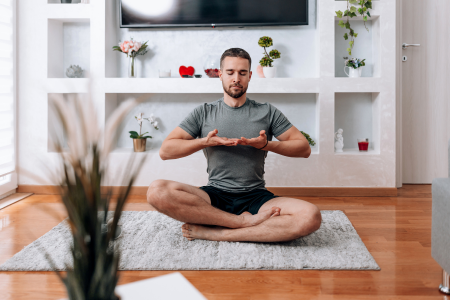As more people embrace remote work and spend increased time at home, the impact of our living environment on our overall well-being becomes ever more apparent. The state of our home directly affects our physical and mental health, whether we commute to the office or not.
Arriving at a cluttered and dirty home can generate unnecessary stress. It is crucial to ensure that your living space promotes cleanliness, safety, and good health. Whether you are constructing a new house or renovating your existing one, there are several steps you can take to design a healthy home that nurtures well-being.
From maintaining air quality to selecting non-toxic building materials, there are numerous ways to cultivate a healthier home environment. Simple tasks like regularly changing bedding and keeping the bathroom clean contribute significantly to the positive spirits and well-being of you and your family.
The Importance of Clean Air in Your Home
As wildfires become more frequent and outdoor air quality declines, it is crucial to prioritize the air quality inside your home. Breathing in indoor air pollution can lead to various health problems, including respiratory illnesses and even cancer.
Even when outdoor air quality is good, certain indoor activities can affect the air you breathe. Smoking and secondhand smoke are well-known for causing numerous health issues and cancers. Everyday activities like cooking, cleaning, and painting can release pollutants into the air. Allergens like dust and mold also impact indoor air quality.
Fortunately, there are steps you can take to maintain clean air in your home. Installing a vent hood or using a microwave fan while cooking can help remove smoke and cooking oil particles from the kitchen. Regularly changing air filters in your HVAC system is another simple way to improve air quality.
Consider using natural cleaning products that do not emit harmful chemicals into the air. Look for green cleaning products made from plant-based materials and be mindful of any allergies you may have.
If you do use chemical products, follow the instructions carefully and avoid mixing them. Mixing certain chemicals can create toxic gases, so it is important to use them separately and as directed.
Adding indoor plants can also help filter the air naturally. Snake plants, peace lilies, spider plants, pothos, ferns, and rubber trees are all excellent choices for improving indoor air quality. Visit a local greenhouse for advice on which plants will work best in your home. NASA recommends having one plant per 100 square feet to enhance air quality and create a healthy home.
Proper ventilation is crucial as well. Implementing improved ventilation strategies, such as opening windows to let in fresh air and enhancing natural airflow, can greatly benefit your home’s air quality. Lastly, if you smoke, avoid smoking indoors. Cigarette smoke lingers in the air and clings to fabrics, posing a significant health risk to both smokers and non-smokers. Step outside to smoke and limit secondhand smoke exposure within your household, especially for children and those with compromised immune systems.
Choosing Non-Toxic Building Materials and Furniture
You might be surprised to discover that many couches contain toxic chemicals. Some furniture brands use stains and finishes that are made with harmful substances. While flame retardants may seem like a good idea for fire safety, prolonged exposure to these chemicals can have negative effects on your health.
The good news is that now is a great time to find non-toxic and eco-friendly alternatives. Look for building materials and furniture made from renewable, upcycled, or recycled materials. If a wooden table can naturally decompose when left outdoors, it is a great non-toxic option.
Furniture with natural fabrics is less likely to contain harmful dyes and finishes. Look for third-party certifications to ensure you bring responsibly sourced furniture into your healthy home.
Opt for furniture and building materials that use low-VOC (Volatile Organic Compounds) paints and finishes. VOCs are chemicals that can be released into the air, causing various health issues. Choosing non-toxic paint or wood finish for your home helps ensure the safety of you and your family.
While natural and sustainable materials are more readily available, it still requires some effort to find them. Buying locally and choosing sustainable pieces reduces your carbon footprint and promotes a healthier home environment.
Locations such as California have implemented strict legislation to help consumers avoid toxic building materials and furniture. Furniture tags often carry warnings for California buyers, so if you see such a warning, consider exploring other options.
In Europe, there are also stringent rules that prohibit certain chemicals commonly used in furniture production in the United States. Staying informed about these bans can help you create a healthier home using natural and sustainable materials. Investing a bit more in non-toxic furniture may seem daunting at first but remember that high-quality materials will ensure the longevity of your furniture. Cheaper options made from modified wood may not last as long and could potentially harm your health.
Tips for Clean and Safe Water
Have you ever been surprised by the taste of tap water when traveling to a different city? Different municipalities treat water differently, and it can affect its taste and quality. However, there are several things you can do to ensure the water in your home is safe and clean.
Drinking contaminated water can lead to various health problems, including bacterial infections and chemical-related illnesses. Even if your water seems clean, its day-to-day quality can impact your skin and hair health. Hard water, for example, leaves mineral deposits that affect the natural pH balance of your skin. It can also harm air-purifying houseplants if used for watering.
Testing your drinking water is simple with online kits that provide valuable insights into its quality. In cases where resources for improving water filtration are limited, water purification tablets can offer a quick fix.
Investing in a water filtration system is one of the easiest ways to improve your home’s water quality. There are various types and sizes available to suit your needs. A reverse osmosis filter, for instance, effectively removes chemicals and contaminants, ensuring clean water flows through your home. Regular cleaning and disinfection of any water storage systems are essential to maintain water cleanliness.
Water softeners are useful for removing hard minerals from your plumbing system and preventing buildup in pipes. Soft water is also beneficial for cleaning clothes, dishes, and bathing, as it is gentler on the skin. Faucet aerators can help diffuse water, making it healthier to drink.
By implementing filters, aerators, and staying on top of plumbing maintenance, you can minimize health issues associated with chlorine and other contaminants in your drinking water. If you encounter plumbing problems, check if your home warranty or insurance covers the repairs to restore your system and ensure clean water as soon as possible.
Maintaining a Clean and Organized Home: Benefits for Physical and Mental Health
A cluttered home can have negative impacts on both your physical and mental well-being. It hides dust, mold, and trash, reminding you of unfinished tasks and overwhelming responsibilities. However, having a clean and well-organized home is essential.
Ensuring your belongings fit on shelves, in closets, or drawers is crucial for a healthy home environment. Clutter is closely tied to procrastination and feeling overwhelmed. Taking small steps to tackle problem areas can provide immediate relief.
For instance, clearing off your dresser’s surface not only improves sleep quality but also makes dusting easier, preventing allergy symptoms and asthma attacks.
When decluttering, start with small areas and gradually work through your home. Sort items into piles to keep, donate, or throw away. Embrace the Marie Kondo method by considering whether each item brings you joy. If not, set it aside to bring joy to someone else’s life.
If you lack time or feel overwhelmed, consider hiring a professional home organization service to help with specific areas. They can guide you in sorting belongings and establishing systems to prevent future issues.
After decluttering, focus on getting organized. Everything should have a designated place. Establishing a regular cleaning routine is essential, and numerous online resources offer weekly or daily schedules to suit your lifestyle. With fewer items, there will be less to pick up.
Staying on top of cleaning and maintenance prevents the accumulation of dust, mold, and allergens in your home. A neat and organized pantry promotes healthy food choices and aids in pest control. Regular shower scrubbing prevents the formation of mold and mildew.
Whenever possible, opt for natural, non-toxic cleaning products to reduce the release of harmful VOCs (Volatile Organic Compounds) into the air. Pay attention to the ingredients, especially if you have pets, as some essential oils can be harmful to them.
Proper storage and organization are key to maintaining your new cleaning routine. Numerous methods and tools are available, including professional home organizers, books, social media accounts, and PDF guides. Find a system that works for you to keep your home clean and your mind calm.
Conclusion
Creating a healthy home involves considering every aspect of your living space. By focusing on improving indoor air and water quality, you can enhance the overall health of your home. Investing in non-toxic furniture and building materials is essential to protect yourself and your family from harmful VOCs (Volatile Organic Compounds). Additionally, incorporating natural sunlight into your home will help you reconnect with nature and uplift your spirits.
Your home should be a sanctuary, providing safety and enjoyment for you and your loved ones. Keeping a clean and decluttered space is not only beneficial for your physical health but also for your mental well-being.
Take the first step towards transforming your home into a healthy haven today. It can be as simple as ordering new air filters or making conscious choices when selecting furniture and building materials. Embrace the opportunity to create a space that promotes wellness and enhances your overall quality of life.




